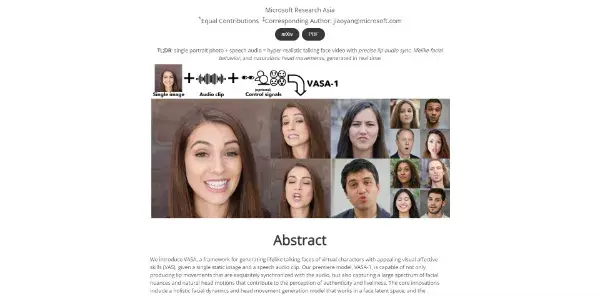VASA-1 by Microsoft

An AI project that generates realistic talking faces from an image or audio clip. Perfect lip-synchronisation, emotions, facial nuances and natural head movements
VASA-1: Microsoft's AI for Realistic Talking Faces
Microsoft's VASA-1 is a groundbreaking AI project within the realm of Large Language Models (LLMs) that specializes in generating incredibly realistic talking faces from a simple input: an image or an audio clip. Unlike many other AI-powered facial animation tools, VASA-1 excels in its ability to achieve perfect lip-synchronization, nuanced emotional expression, and lifelike head movements. This article delves into the capabilities, applications, and implications of this innovative technology.
What VASA-1 Does
VASA-1 takes the input of either a still image of a person's face or an audio clip and generates a high-fidelity video of that person speaking. The AI meticulously synchronizes the generated lip movements with the provided audio, creating a seamless and convincing visual experience. Further, VASA-1 goes beyond mere lip-sync; it also animates facial muscles to reflect the nuances of emotion conveyed in the audio, resulting in a far more expressive and realistic presentation than its predecessors. The natural head movements add to the overall realism, making the generated video indistinguishable from actual footage in many instances.
Main Features and Benefits
- Realistic Lip-Synchronization: VASA-1's key strength lies in its precise lip-sync capabilities, ensuring that the generated facial movements perfectly match the audio's phonetic content.
- Expressive Facial Animation: The AI goes beyond simple lip movements, generating subtle facial expressions that reflect the emotional tone of the audio, resulting in a much more engaging and believable animation.
- Natural Head Movements: The generated videos include natural and fluid head movements, enhancing the realism and creating a more immersive viewing experience.
- High-Fidelity Visuals: VASA-1 produces high-resolution video output, making the generated faces incredibly realistic and detailed.
- Ease of Use: While the underlying technology is complex, the tool's interface (if one exists publicly) is designed for straightforward use, even for users without extensive technical skills.
Use Cases and Applications
The applications of VASA-1 are extensive and span various industries:
- Film and Television: Creating realistic digital doubles for actors, generating scenes with minimal filming requirements, and enhancing post-production effects.
- Video Game Development: Generating realistic character animations, reducing development time and costs.
- Virtual Assistants and Chatbots: Giving virtual assistants a more engaging and personable appearance, enhancing user interaction.
- Education and Training: Creating immersive and engaging educational content, particularly for language learning and communication training.
- Accessibility: Providing a visual representation for audio content, making it more accessible for people with hearing impairments.
- Marketing and Advertising: Creating personalized marketing messages with realistic video avatars.
Comparison to Similar Tools
VASA-1 distinguishes itself from other AI-based talking face generators through its superior realism and attention to detail. While several other tools offer similar functionality, VASA-1 often surpasses them in terms of lip-synchronization accuracy, emotional expressiveness, and overall naturalness of the generated videos. A detailed comparison with competing tools would require a direct benchmark study, but anecdotal evidence suggests a high degree of realism.
Pricing Information
Currently, VASA-1 is available for free. However, this may change as the technology matures and enters more commercial applications. The current free access likely serves as a research and demonstration phase.
Conclusion
VASA-1 represents a significant advancement in AI-driven video generation. Its ability to create highly realistic talking faces from minimal input opens up numerous possibilities across a wide range of industries. As the technology develops and becomes more widely available, its impact on visual communication and entertainment will undoubtedly be substantial. The current free access makes it an exciting tool for researchers and developers to explore its potential.